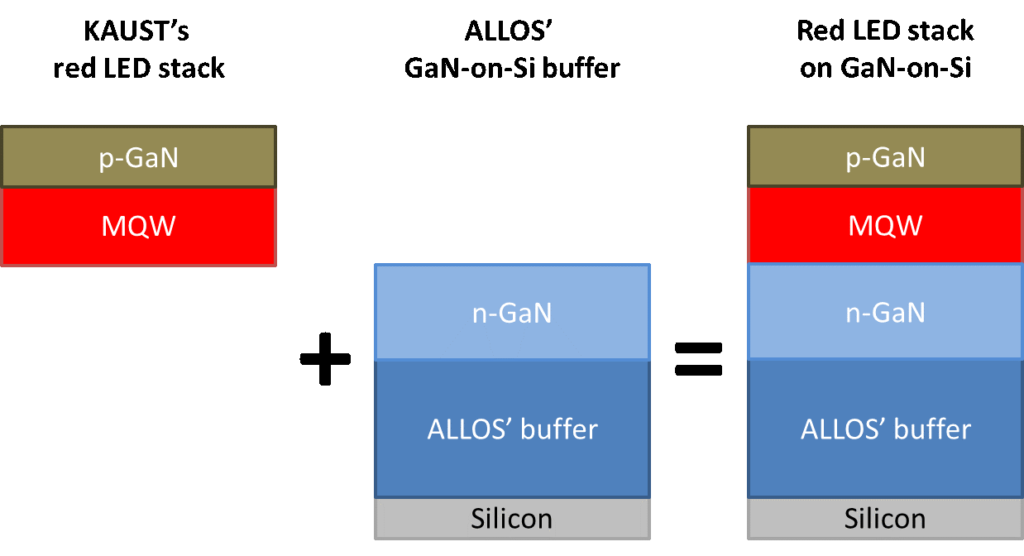Dresden, Germany – 21th July 2020 – ALLOS Semiconductors has engaged in a collaboration with Prof. Ohkawa and his team at King Abdullah University of Science and Technology (KAUST) for realizing high efficiency nitride-based red LEDs on large diameter silicon substrates.
In the collaboration the teams are addressing fundamental issues like the large lattice mismatch and the quantum-confined Stark effect (QCSE) which are preventing the adoption of red nitride-based LEDs for practical industry usage. In particular, for the emerging field of micro LED displays there is a strong demand to enable red LEDs on large diameter wafers in addition to the established blue and green color LEDs in the nitride system in order to reduce manufacturing complexity and cost.
In this context, Prof. Ohkawa and team have developed an indium gallium nitride (InGaN)-based red LED stack with low forward voltage of less than 2.5 V and high efficiency by using local strain compensation and a modified MOCVD reactor design. The researchers have already grown red LEDs on sapphire- and Ga2O3-substrates [1, 2]. For potentially higher performance red LEDs by using strain-engineering on wafer-level – in particular for large wafer diameters – the team is now extending its work to silicon substrates by collaborating with ALLOS. This also enables huge advantages for mass production due to the scalability of up to 300 mm and thus processability in silicon process lines. For micro LED displays – in particular the monolithically integrated micro displays for e.g. augmented reality (AR) application – this is another important enabler.

The unique high crystal quality of ALLOS’ gallium nitride on silicon (GaN-on-Si) technology with threading dislocation density (TDD) of ~2 x 108 cm-2 is the pre-condition to achieve at least the same performance red LED as on sapphire. Furthermore, ALLOS’ precise strain-engineering – which enables excellent emission uniformity for blue and green LED as well as flat bow wafer for 200 and 300 mm diameters – is used to optimize the growth conditions for red LED.
Both teams combine their unique technologies to handle strain and optimize crystal growth conditions for GaN-on-Si and red LEDs. To this end, the KAUST team will grow its red LED stack on top of ALLOS’ GaN-on-Si-buffer layers, which will be fine-tuned during the collaboration to optimize the performance of KAUST’s red LED stack:

Dr. Nishikawa co-founder and CTO of ALLOS, commented: “From personal experience I am aware how challenging it is to realize high efficiency red LED. From ALLOS’ side we can provide our established blue and green high quality GaN-on-Si micro LED epiwafers of up to 300 mm diameter. Furthermore we see the opportunity that our unique strengths in strain-engineering can contribute to improved red LED performance.”
Commenting on the opportunity, Prof. Ohkawa said: “Our team has developed a high efficient red LED stack and continues to push the boundaries in this very challenging field. When talking to ALLOS, we of course were interested in the scalability up to 300 mm – but the capability to control the strain-engineering so precisely and in such a large process windows promises more progress for red LED performance.”
About Prof. Ohkawa at KAUST
Prof. Ohkawa is devoted to the development of nitride semiconductors for more than 20 years. He and his team at KAUST have successfully developed a specially strain compensated red LED stack and additionally have used their own MOCVD reactor design, which makes possible to realize high-quality and high In-content InGaN alloys by use of special features [3]. These technologies open a new way for high-performance nitride-based red LED for micro LED application. Now he and his team want to demonstrate their red LED technologies on large wafer diameters using ALLOS’ GaN-on-Si technology.
About ALLOS Semiconductors
The ALLOS team looks back to 17 years of successful GaN-on-Si epiwafer technology development for up to 300 mm wafer diameter and today is focusing its world-leading technologies on enabling the next generation of revolutionary displays based on micro LEDs. The company can make its technology available through IP licensing and transferring the technology to its customers’ MOCVD reactors. Additionally ALLOS is working with partners in advancing the technologies needed for micro LED mass production.
For further information about ALLOS’ technology, licensing options and how to cooperate with ALLOS in the exciting field of micro LEDs, please contact:
ALLOS Semiconductors GmbH
Alexander Loesing
Breitscheidstrasse 78, 01237 Dresden, Germany
Phone: +49-351-212 937-20
Email: alexander.loesing@allos-semiconductors.com
References:
[1] “633-nm InGaN-based red LEDs grown on thick GaN underlying layers with reducing in-plane residual stress”, D. Iida, Z. Zhuang, P. S. Kirilenko, M. Velazquez-Rizo, and K. Ohkawa, Applied Physics Letters 116, 162101 (2020). DOI: 10.1063/1.5142538
[2] “Demonstration of low forward voltage InGaN-based red LEDs on β-Ga2O3 substrates”, D. Iida, Z. Zhuang, P. S. Kirilenko, M. Velazquez-Rizo, and K. Ohkawa, Applied Physics Express 13, 031001 (2020). DOI: 10.35848/1882-0786/ab7168
[3] ”Metalorganic vapor-phase epitaxial growth simulation to realize high-quality and high-In-content InGaN alloys”, K. Ohkawa, F. Ichinohe, T. Watanabe, K. Nakamura, D. Iida, Journal of Crystal Growth 512, pp.69-73 (2019). DOI: j.jcrysgro.2019.02.018
This press release is available for download (pdf format) in English and Chinese.